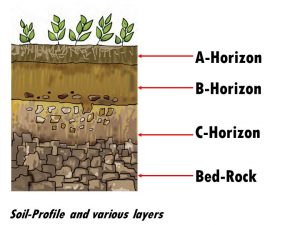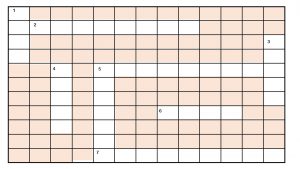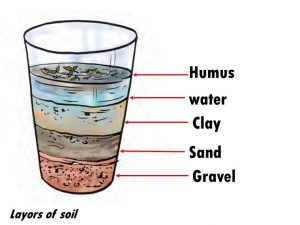Soil
Exercise:
Tick the most suitable answer in questions 1 and 2.
1). In addition to the rock particles, the soil contains
(i) air and water
(ii) water and plants
(iii) minerals, organic matter, air and water
(iv) water, air and plants
Ans: iii) minerals, organic matter, air and water
2). The water holding capacity is the highest in
(i) sandy soil
(ii) clayey soil
(iii) loamy soil
(iv) mixture of sand and loam
Ans: (ii) clayey soil
3). Match the items in Column I with those in Column II:
Column I Column II
(i) A home for living organisms (a) Large particles
(ii) Upper layer of the soil (b) All kinds of soil
(iii) Sandy soil (c) Dark in colour
(iv) Middle layer of the soil (d) Small particles and
packed tight
(v) Clayey soil (e) Lesser amount of humus
Answer:
Column I Column II
(i) A home for living organisms All kinds of soil
(ii) Upper layer of the soil Dark in colour
(iii) Sandy soil Large particles
(iv) Middle layer of the soil Lesser amount of humus
(v) Clayey soil Small particles and packed tight
4). Explain how soil is formed.
Ans: Soil is formed by the breaking down of rocks by the action of wind, water and climate. This process is called weathering. The nature of any soil depends upon the rocks from which it has been formed and the type of vegetation that grows in it.
5). How is clayey soil useful for crops?
Ans: Clayey soil is useful for crops because of the following features-
(i) Water holding capacity is high in clayey soil
(ii) Percolation rate is least in clayey soil.
(iii) It is fertile in nature.
6). List the differences between clayey soil and sandy soil.
| Clayey Soil | Sandy Soil |
| 1. If the proportion of fine particles is relatively higher, then it is called clayey soil. | 1. If soil contains greater proportion of big particles it is called sandy soil. |
| 2. It has good water holding capacity. | 2. It has poor water holding capacity. |
7). Sketch the cross-section of soil and label the various layers.

8). Razia conducted an experiment in the field related to the rate of percolation. She observed that it took 40 min for 200 mL of water to percolate through the soil sample. Calculate the rate of percolation.
Amount of percolated water = 200 mL
Time taken = 40 min
Rate of percolation = Amount of percolated water
Percolation time
= 200
40
= 5 mL/min
Ans: Rate of Percolation = 5 mL/min
9). Explain how soil pollution and soil erosion could be prevented.
Ans: Prevention of soil pollution:
(i). Ban on polythene bags.
(ii). Waste products and chemicals should be treated before they are released into the soil.
(iii). The use of pesticides should be minimised.
Prevention of soil erosion:
(i). Plant more trees.
(ii). Protection of forests.
(iii). Efforts should be made to increase the green areas.
(iv). maintaining porous structure of soil.
10). Solve the following crossword puzzle with the clues given:
Across
2). Plantation prevents it.
5). Use should be banned to avoid soil pollution.
6). Type of soil used for making pottery.
7). Living organisms in the soil.

Down
1). In the desert soil erosion occurs through.
3). Clay and loam are suitable for cereals like.
4). This type of soil can hold very little water.
5). Collective name for layers of soil.
Answer

Additional Questions:
Fill in the blanks.
i). Soil is essential for agriculture.
ii). The humus makes the soil fertile.
iii). The layers of soil are referred to as horizons.
iv). The best topsoil for growing plants is loam.
vi). Silt occurs as a deposit in riverbeds.
vii). Soil is formed by weathering of rocks.
Write whether True or False.
i). Agriculture provides food, clothing and shelter for all.
Ans: True
ii). The use of pesticides should be minimised.
Ans: True.
iii). The uppermost horizon is rich in minerals.
Ans: False.
iv). The second horizon of soil is rich in humus.
Ans: False.
v). The size of the particles in a soil has an influence on its properties.
Ans: True.
vi). Clayey soil has less air.
Ans: True.
vii). Loam occurs as a deposits in riverbeds.
Ans: False.
viii). Clayey soil is used to make toys and pots.
Ans: True.
Answer the following in one sentence each.
1). What is humus?
Ans: The rotting dead matter in the soil is called humus.
2). What is soil profile?
Ans: A vertical section through different layers of the soil is called the soil profile.
3). What is soil?
Ans: The mixture of rock particles and humus is called soil.
4). What are the factors that influence soil formation?
Ans: Factors that influence the soil formation are wind, rainfall, temperature, light and humidity.
5). What is soil erosion?
Ans: The removal of land surface by water, wind or ice is known as soil erosion.
6). Which horizon of the soil is most suitable for growth of plants?
Ans: The uppermost layer of soil A-horizon is most suitable for growth of plants.
7). Write the uses of sandy soil?
Ans: Sandy soil is used for construction of buildings along with
Write a short note on
1). A- horizon
Ans: Each layer differs in feel (texture), colour, depth and chemical composition. These layers are referred to as horizons.
The uppermost horizon is generally dark in colour as it is rich in humus and minerals. The humus makes the soil fertile and provides nutrients to growing plants. This layer is generally soft, porous and can retain more water. It is called the topsoil or the A-horizon. This provides shelter for many living organisms such as worms, rodents, moles and beetles. The roots of small plants are embedded entirely in the topsoil.
2). B-horizon
Ans: The second layer of soil has a lesser amount of humus but more of minerals. This layer is generally harder and more compact and is called the B-horizon or the middle layer.
3). C-horizon
Ans: The third layer is the C-horizon, which is made up of small lumps of rocks with cracks and crevices below this layer is the bedrock, which is hard and difficult to dig with a spade.
4). Write the classification of soil?
Ans: The soil is classified on the basis of the proportion of particles of various sizes. If soil contains greater proportion of big particles it is called sandy soil. If the proportion of fine particles is relatively higher, then it is called clayey soil. If the amount of large and fine particles is about the same, then the soil is called loamy. Thus, the soil can be classified as sandy, clayey and loamy.
Give reason
1). Wheat crops are grown in clayey soils.
Ans: Wheat crops are grown in clayey soils because they are rich in humus and very fertile.
Label the different layers of soil.

Click here for the solutions of
6). Physical and Chemical Changes
7). Weather, Climate and Adaptations of Animals to Climate
8). Winds, Storms and Cyclones
11). Transportation in Animals and Plants
14). Electric Currents and its Effects
16). Water: A Precious Resource
![]()

